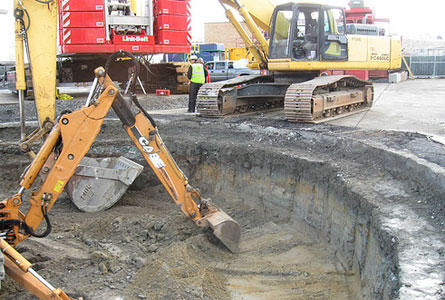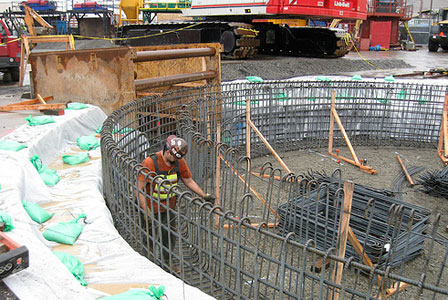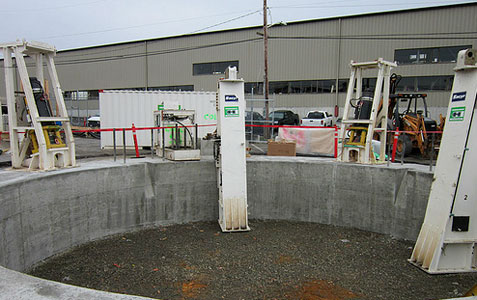US debut for vertical shaft machine technology
Apr 2012
Peter Kenyon, TunnelTalk
- Vertical shaft machine (VSM) technology is being used for the first time on a North American tunneling project.
- Ballard Siphon Project General Contractor James W. Fowler of Oregon has partnered with Herrenknecht to use the German manufacturer's VSM technology to construct a 145ft x 30ft launch shaft on the south shore of Seattle's Lake Washington ship canal.
- A 2.6m diameter Herenknecht EPBM, which is currently completing a short drive in England, is scheduled to launch on its 2,000ft drive in September.
-

Herrenknecht VSM at the south shore launch shaft
- The main parts of the VSM began arriving from Spain in February, with assembly beginning in the early part of March. Shaft excavation is expected to start next week, on or after April 16, with completion scheduled for June. Traditional construction methods, such as pile driving and ground freezing, would have taken 2-3 months longer.
- Risk sharing
The Herrenknecht/ James W. Fowler JV was formed after a series of events occurred whereby the General Contractor was unable to come to terms, on grounds of cost and schedule, with their original subcontractor to build a slurry wall. So instead James W. Fowler formed a JV with Herrenknecht to create a new shaft subcontractor, Fowler Shaft Contractors, and will use a VSM to install a caisson shaft. - According to King County Project Representative Marty Noble, American reluctance to use the caisson method for shaft excavations over 80ft deep in areas like Seattle's Puget Sound, which suffers from complex geological and groundwater conditions, could now change.
- The technology has been used in Europe and the Middle East for the last 6-7 years, but so far has not been utilized on American soil.
- Noble told TunnelTalk from Seattle: "King County, as a public owner, typically doesn't make decisions on the means and methods for constructing the design intent of a project. Our contract specifications are more performance based as opposed to being prescriptive, as are most public, design-bid-build projects."
-

King County Project Representative Marty Noble
- "For example, this project allowed for three types of shaft construction – caisson, slurry wall or ground freezing. In other words - what we wanted, not how to do it. Because most projects in the US are based on the low bid concept, contractors do not go out of their way to try out new and potentially risky means and methods. The low bid generally cannot support the financial hit if things go wrong. In some parts of Europe and the Middle East the culture of public and/ or major private contracting is sometimes based on partnering arrangements where the gain (or loss) resulting from the use of new technology is shared."
- "This helps immensely with the contractor's ability/ willingness to try new methods. On the Ballard Siphon Project a series of events occurred where the General Contractor, the James W. Fowler Company, was unable to come to terms with their original subcontractor to build a slurry wall, and partnered with Herrenknecht to Install a caisson shaft with the VSM."
-

Ballard siphon replacement alignment
- Lesser of three evils
Noble explained: "The depth of the shaft (145ft) would have made a traditionally installed caisson shaft extremely risky because of problems associated with keeping the shaft vertical as it went down. A slurry diaphragm wall shaft would be the logical choice for most contractors but in this case the equipment/ specialty contractor was not available to meet the project schedule/ budget. Slurry wall construction is a highly specialized method of construction and no other contractor was immediately available. - "The contractor looked at ground freezing but because of the complex geology/ groundwater conditions felt this method was too risky to the project schedule. Left with the not so pleasant aspects of all three of the above scenarios the contractor chose to partner with Herrenknecht to use the VSM to install a caisson."
- The biggest risk with this method is the ability to keep the caisson vertical as it descends. Because the clam bucket cannot excavate directly below the shaft, it may begin sinking unevenly and eventually get stuck before it reaches the desired depth. While there are methods to mitigate this problem the caisson usually has to remain flooded with water (no visibility) to equal out groundwater pressures. Attempts to maintain verticality to avoid the caisson from getting wedged into the formation can be very difficult and costly.
- Noble said: "In the Puget Sound area if a shaft needs to be deeper than 80ft it won't be done with the caisson method. However VSM technology may change that idea. With VSM, the caisson is held from sinking on its own by four sets of 20 steel cables each anchored to hydraulic strand jacks at the ground surface. The descent of the caisson can be precisely controlled thus maintaining verticality. The digging arm of the VSM is able to excavate directly below the caisson cutting shoe, removing any obstructions that may prevent the shaft for going down evenly. The excavating is also precisely controlled by an operator inside a surface mounted control station. Remember, all of excavation is done underwater with no visibility from the surface."
- The TBM is scheduled to launch from the shaft in September (2012), and will run below the existing 77-year-old wooden dual siphons, which will be slip lined as part of the project, beneath Salmon Bay.
- In addition to being less disruptive than traditional shaft construction, VSM works well in tightly confined city spaces and in areas with difficult soils and high water tables. The machine is also powered by electricity and does not require the continuous operation of noisy diesel generators.
- The shaft is kept full of water during excavation to help balance groundwater levels and to allow the excavated material to be pumped out and sent through separation equipment for disposal. The machine is capable of excavating and lining 3ft-15ft each day.
- The new siphon, about 60ft beneath Salmon Bay, will run from Seattle's Ballard Regulator Station to the North Interceptor in the Interbay. Owner, King County specified EPBM over horizontal directional drilling and microtunneling methods, because it was deemed the least risky and would have the least impact on local neighborhoods and businesses. In addition to the technical challenges, space is limited by underground utilities, railroad tracks and businesses on both sides of Salmon Bay.
- Seattle mobilizes for sewer upgrade - TunnelTalk, September 2011
|
|
|
|
|
Add your comment
- Thank you for taking the time to share your thoughts and comments. You share in the wider tunnelling community, so please keep your comments smart and civil. Don't attack other readers personally, and keep your language professional.






